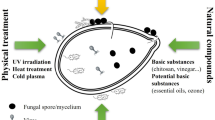Abstract
Wheat, barley, and maize, each in 15-kg parcels at 15 and 19% initial moisture content (IMC), were kept in a Bavarian farm granary from June through November 1990. During this period, the grain at each IMC was analyzed for mycotoxins and monitored for grain temperature, carbon dioxide, seed germination, and microfloral incidence and abundance. Barley and maize stored for 20 weeks at 19% IMC contained ochratoxin A in amounts of 70 and 90 μg/kg, respectively. This mycotoxin was not detected in wheat stored at 19% IMC, nor in the grains stored at 15% IMC. Aflatoxin B1, sterigmatocystin, citrinin, and zearalenone were also assayed but not detected in grains stored at either IMC. Principal component analysis of the data indicated that ochratoxin A was produced in a damp niche in maize, when abundant metabolic activity and CO2 production by Penicillium glandicola and Aspergillus spp. were common.
Similar content being viewed by others
References
Abramson D (1991) Development of molds, mycotoxins and odors in moist cereals during storage. In: Chelkowski J (ed), Cereal grain: Mycotoxins, fungi and quality in drying and storage. Elsevier Science Publishers, Amsterdam, pp 119–148
Abramson D, Sinha RN, Mills JT (1980) Mycotoxin and odor formation in moist cereal grain during granary storage. Cereal Chem 57:346–351
—, —, — (1983) Mycotoxin and odor formation in barley stored at 16 and 20% moisture in Manitoba. Cereal Chem 60:350–355
—, —, — (1985) Mycotoxin formation and quality changes in granary-stored maize at 16 and 21% moisture content. Sci Alim 5:653–663
—, —, — (1991) Mycotoxin formation in HY-320 wheat during granary storage at 15 and 19% moisture content. Mycopathologia 111:181–189
Abramson D, Thorsteinson T, Forest D (1989) Chromatography of mycotoxins on precoated reverse-phase thin-layer plates. Arch Environ Contam Toxicol 18:327–330
Bauer J, Gareis M (1987) Ochratoxin A in the food chain. Z. Veterinärmed B34:613–627
Bauer J, Gareis M, Gedek B (1984) Detection and occurrence of ochratoxin A in slaughter pigs. Berliner and Münchener Tierärztliche Wochenschrift 97:279–83
--, --, --(1986) Incidence of ochratoxin A in blood serum and kidneys of man and animals. Proc 2nd World Cong Foodborne Infections and Intoxications, Berlin, p 907 (Abstr)
Christensen, CM (1978) Storage fungi. In: Beuchat LR (ed) Food and beverage mycology. AVI Publishing Co, Westport, CT, pp 173–190
Corry JE (1978) Relationships of water activity to fungal growth. In: Beuchat LR (ed) Food and beverage mycology. AVI Publishing Co, Westport, CT, pp 45–82
Gareis M, Märtlbauer E, Bauer J, Gedek B (1988) Determination of ochratoxin A in human milk. Z Lebensm Unters Forsch 186:114–117
Lillehoj EB, Elling F (1983) Environmental conditions that facilitate ochratoxin contamination of agricultural commodities. Acta Agric Scand 33:113–127
Mirocha CJ, Christensen CM (1982) Mycotoxins. In: Christensen CM (ed) Storage of cereal grains and their products, 3rd ed. American Association of Cereal Chemists, St. Paul, MN, pp 241–280
Richter W (1989) Suspect grains. In: Feed conservation and suspect grains, Bavarian Ministry for Nutrition, Agriculture and Forestry, Brochure No. 30, Munich, pp 37–55
Samson RA, Pitt JJ (eds) (1989) Modern concepts in Penicillium and Aspergillus classification. Plenum Press, NY
SAS Institute Inc (1985) SAS users' guide, basics and statistics version, 5th edition, SAS Institute Inc, Cary, NC
Seal H (1965) Multivariate statistical analysis for biologists, McGraw-Hill, NY
Scott PM, van Walbeek W, Kennedy B, Anyeti D (1972) Mycotoxins (ochratoxin A, citrinin and sterigmatocystin) and toxigenic fungi in grains and other agricultural products. J Agric Food Chem 20:1103–1109
Stoloff L, Scott PM (1984) Natural poisons. In: Williams S (ed) Official methods of analysis, 14th ed. Association of Official Analytical Chemists, Arlington, VA, pp 477–500
VDLUFA (1988) Bestimmung der Feuchtigkeit. Methoden Band 3.1, Amtliche Methode. Verband Deutscher Landwirtschaftlicher Untersuchungs- und Forschungsanstalten Verlag, Darmstadt
Wilson DM, Abramson D (1992) Mycotoxins. In: Sauer DB (ed) Storage of cereal grains and their products, 4th ed. American Association of Cereal Chemists, St. Paul, MN, pp 341–391
Wilson DM, Tabor WH, Trucksess MW (1976) Screening method for the detection of aflatoxins, ochratoxin, zearalenone, penicillic acid and citrinin. J Assoc Offic Anal Chem 59:125–127
Author information
Authors and Affiliations
Additional information
Contribution No. 1476 of the Agriculture Canada Research Station.
Rights and permissions
About this article
Cite this article
Abramson, D., Richter, W., Rintelen, J. et al. Ochratoxin a production in Bavarian cereal grains stored at 15 and 19% moisture content. Arch. Environ. Contam. Toxicol. 23, 259–265 (1992). https://doi.org/10.1007/BF00212284
Received:
Revised:
Issue Date:
DOI: https://doi.org/10.1007/BF00212284




